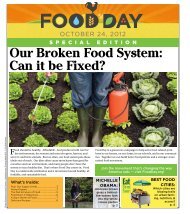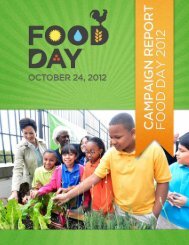Industrial Food Animal Production and the High-meat ... - Food Day
Industrial Food Animal Production and the High-meat ... - Food Day
Industrial Food Animal Production and the High-meat ... - Food Day
You also want an ePaper? Increase the reach of your titles
YUMPU automatically turns print PDFs into web optimized ePapers that Google loves.
<strong>Industrial</strong> <strong>Food</strong> <strong>Animal</strong><br />
<strong>Production</strong> <strong>and</strong> <strong>the</strong> <strong>High</strong>-<strong>meat</strong> Diet:<br />
Health <strong>and</strong> Environmental Consequences<br />
A Webinar in Anticipation of<br />
<strong>Food</strong> <strong>Day</strong>, October 24<br />
June 28, 2011<br />
Robert S. Lawrence, MD<br />
Director, Center for a Livable Future (CLF);<br />
Keeve Nachman, PhD, MHS<br />
Director, Farming for <strong>the</strong> Future Program, CLF<br />
Johns Hopkins Bloomberg School of Public Health
Diverse <strong>and</strong> Resilient to Specialized
<strong>Food</strong> <strong>Animal</strong> <strong>Production</strong> in <strong>the</strong> US has been<br />
Transformed over <strong>the</strong> Last 50 Years<br />
Estimated 91 billion food animals<br />
produced annually in <strong>the</strong> US<br />
Source: Agricultural Statistics Board, NASS-USDA. Statistics by Subject.<br />
http://www.nass.usda.gov/Statistics_by_Subject/index.asp
Localization of <strong>Production</strong><br />
(Aho, 2003)<br />
(USDA, 2009)<br />
1949<br />
Poultry processing plants<br />
• Each dot represents a plant processing<br />
50,000 or more chickens each year<br />
2007<br />
Chicken production<br />
• Each dot represents annual<br />
production of 1 million or more<br />
chickens
Retail cut equiv./lb. per person<br />
300<br />
225<br />
150<br />
75<br />
Meat Consumption<br />
Continues to Increase in US<br />
U.S. Per Capita Meat Consumption 1950 - 2007*<br />
0<br />
1950 1960 1970 1980 1990 2000 2002 2004 2006*<br />
*Data for 2005 is an estimate; data for 2006-2007 are projections<br />
^Excluding veal<br />
Source: USDA, Economic Research Service<br />
Total<br />
Chicken<br />
Beef^<br />
Pork<br />
Turkey<br />
Veal
Meat Consumption in America<br />
Meat consumption comparison<br />
(pounds per person per year)
The link between diet <strong>and</strong> health<br />
Diets high in <strong>meat</strong> <strong>and</strong> saturated fat<br />
increase our risk for heart disease,<br />
stroke, cancer <strong>and</strong> diabetes.<br />
Healthy, low-fat meal<br />
Typical American meal high<br />
in fat <strong>and</strong> saturated fat<br />
Diets high in fruit, vegetables, whole<br />
grains, beans <strong>and</strong> low-fat dairy foods<br />
help prevent <strong>the</strong>se same diseases.
2009-10 Slaughter <strong>and</strong> Inventory<br />
Statistics for US Livestock<br />
<strong>Animal</strong> # Slaughtered/year Inventory<br />
Chickens 8,658,860,000* Not given<br />
Hogs 113,733,800 64,400,000<br />
Cattle & calves 33,300,000 93,700,000<br />
Sheep & lambs 2,611,200 6,900,000<br />
Turkeys 245,768,000 Not given<br />
Total 9,054,273,000 -<br />
* 1 million per hour<br />
Source: USDA 2010
A campaign of The Monday Campaigns in association<br />
with Johns Hopkins Bloomberg School of Public Health
Health Impacts of <strong>Industrial</strong> <strong>Food</strong><br />
<strong>Production</strong> Methods<br />
• Environment<br />
• Soil<br />
• Water<br />
• Air<br />
• Biodiversity<br />
• Chemicals, hormones, endocrine disrupters,<br />
pesticide residues<br />
• Antibiotics <strong>and</strong> Ab-resistant bacteria<br />
• Loss of social capital in rural America<br />
• Global climate change
Community Health Effects<br />
Associated with Swine CAFOs<br />
• <strong>High</strong>er rates of respiratory<br />
problems, nausea, diarrhea,<br />
headaches, <strong>and</strong> plugged ears<br />
• <strong>High</strong>er rates of eye, nose,<br />
<strong>and</strong> throat irritation<br />
• Significantly more episodes<br />
of depression, anxiety, anger,<br />
fatigue, <strong>and</strong> confusion among<br />
neighbors of swine CAFOs<br />
Schiffman et al. (1995). Brain Research Bulletin.<br />
Thu. (2002). Journal of Agricultural Safety <strong>and</strong> Health.<br />
Wing <strong>and</strong> Wolf. (2000). Environmental Health Perspectives.
Use of Chemicals<br />
• Over 1,600 chemicals used in<br />
<strong>the</strong> manufacture of pesticide —<br />
most have not been tested<br />
• Worldwide, >6 million tons<br />
of pesticides per year<br />
• Human health<br />
• Poisonings; long-term effects on<br />
<strong>the</strong> immune, reproductive, <strong>and</strong><br />
nervous systems; increased<br />
cancer risk
12 Most<br />
Contaminated:<br />
Peaches<br />
Apples<br />
Sweet Bell Peppers<br />
Celery<br />
Nectarines<br />
Strawberries<br />
Cherries<br />
Pears<br />
Grapes (Imported)<br />
Spinach<br />
Lettuce<br />
Potatoes<br />
Pesticides in Produce<br />
www.foodnews.org<br />
12 Least<br />
Contaminated:<br />
Onions<br />
Avocados<br />
Sweet Corn (Frozen)<br />
Pineapples<br />
Mango<br />
Asparagus<br />
Sweet Peas (Frozen)<br />
Kiwi Fruit<br />
Bananas<br />
Cabbage<br />
Broccoli<br />
Papaya
Produce Contamination <strong>and</strong><br />
Human Illness<br />
• Approx. 48 million cases of foodborne<br />
illness in <strong>the</strong> U.S. per year (CDC<br />
estimates)<br />
• <strong>Food</strong>borne illness associated with<br />
produce is increasing over time
How Much Waste?<br />
Approx. one dry ton of animal waste<br />
generated for every US citizen<br />
Treated Untreated<br />
Human Waste <strong>Animal</strong> Waste<br />
Generated/yr 6.9 million dry tons<br />
Applied to L<strong>and</strong>/yr 3.9 million dry tons<br />
287 million dry tons<br />
>270 million dry tons
What’s in <strong>Animal</strong> Waste?<br />
• Bacteria<br />
• Protozoa<br />
• Viruses<br />
• <strong>Animal</strong> d<strong>and</strong>er<br />
• Pharmaceuticals<br />
• Heavy metals<br />
• Hormones<br />
• Nutrients<br />
Photo credit: SRA Project
Antibiotic Use:<br />
Feed Additives vs. Human Medicine
Origins <strong>and</strong> Perpetuation of Resistance<br />
Primary mechanisms of development <strong>and</strong> dissemination of resistance:<br />
• Natural selection<br />
• Sharing of resistance genes<br />
• Mutagenesis<br />
• Reservoir of resistance<br />
Recent findings:<br />
• Community dynamics
Resistance Selection<br />
R.I.P.
Horizontal gene transfer<br />
from Fuyura, Nature Reviews<br />
Microbiology, 2006
Conditions Promoting<br />
Resistance in Agriculture<br />
• Failure of infection control<br />
– Crowding<br />
– Often sub-optimal hygiene<br />
• Exposure to antibiotics<br />
– Widespread<br />
– Prolonged<br />
– Sub-lethal doses<br />
– Often little dose control<br />
• Stress reaction<br />
– Increases bacterial shedding
Thank You!<br />
Robert S. Lawrence, MD<br />
Director, Center for a Livable Future (CLF)<br />
Keeve Nachman, PhD, MHS<br />
Director, Farming for <strong>the</strong> Future Program, CLF<br />
Johns Hopkins Bloomberg School of Public Health<br />
OUR WEBSITES:<br />
www.jhsph.edu/clf<br />
http://aphg.jhsph.edu/<br />
OUR BLOG:<br />
www.livablefutureblog.com








